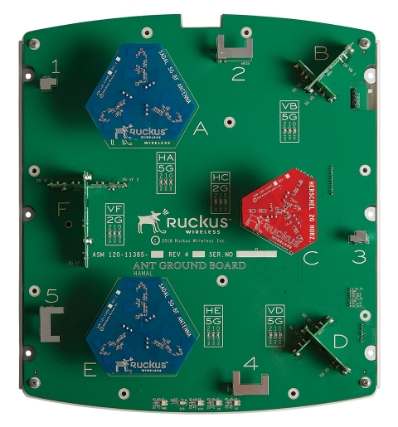Wi-Fi
BeamFlex+
Are all Wi-Fi networks the same? No, they aren’t. The design and quality of radio and antenna systems in a Wi-Fi access point are prerequisites for high-quality, ultra-fast, and reliable wireless communication.
Ordinary APs are built using static antennas which are nothing but pieces of metal designed to transmit radio signal. RUCKUS APs are different in that they are equipped with the unique, patented, smart driven BeamFlex+ adaptive antennas which radiate radio signals in the direction where the Wi-Fi client is actually located. In RUCKUS Wi-Fi networks the signal follows the client in real time. BeamFlex+ requires no set-up of the Wi-Fi clients. It supports any Wi-Fi generation, from the early 802.11a/b/g to the latest Wi-Fi 6/6E standards.
RUCKUS BeamFlex+ offering will provide your Wi-Fi network with:
- reliable transmission,
- more efficient roaming,
- higher network user capacity,
- improved data rate,
- larger network coverage.
Simply put, expect a more effective communication within your organization.
PD-MRC
OK. But what about transmission from Wi-Fi clients to the AP, given that mobile devices have weaker radios and less advanced antennas? It is true.
This is addressed by two technologies in RUCKUS solutions:
- BeamFlex+ to amplify the upstream transmission from the client to the AP for the Wi-Fi 6/6E generation,
- PD-MRC to improve transmission performance from clients using legacy standards to the AP.
What is PD-MRC and why is it so important? On its path between the transmitter and the receiver, radio signal is subject to multiple reflections from numerous obstacles, planes, and objects. These reflections create further copies of the signal which in turn reach the receiver through many different paths in space. Each path has different length, which is why many different distorted copies of the same signal reach the receiver (multipath propagation). In addition, the copies reach the receiver at different points in time, which results in blurring the original message.
To cope with this, the MRC (Maximal Ratio Combining) technique is used to recreate a readable original signal from its many time-shifted copies received at the receiver.
There are also other challenges that the receiver has to address. The receiver’s antenna and signal polarization are other important factors determining efficient radio communication. As described above, the signal and its copies move along complex paths in three planes. This leads to a mismatched polarization between the received signal and the antenna at an ordinary AP, which cannot be helped by MRC alone. As a result, the transmission performance drops, retransmissions occur, vulnerable applications such as voice messaging and video apps perform poorly, the network slows down, and users start to report issues.
This is why RUCKUS Wi-Fi took one further step to improve the ability to receive weak and distorted signals by developing the PD-MRC (Polarization Diversity MRC) designed to efficiently use MRC techniques despite dynamic changes in the polarization of the received signal.RUCKUS PD-MRC has the following benefits:
- improved reception of even weak, low-quality signal in adverse RF transmission conditions,
- no retransmission,
- more satisfied users of Wi-Fi services.
SmartCast
Today, communications environments include a mix of various applications, needs, and types of clients. It is extremely difficult to develop a solution that can quickly and efficiently meet the requirements of each of these groups at the same time.
Most ordinary wireless solutions employ a simple implementation of only four classes of network traffic, defined years ago in the 802.11e/Wi-Fi Multi Media specification.
RUCKUS chose the innovative SmartCast solution which raised the mechanisms assuring the quality of network services to a completely new level. SmartCast automatically identifies network applications to ensure outstanding performance of each client irrespective of the Wi-Fi generation it supports.
At the same time, SmartCast prevents unpredictable transmissions of single clients from adversely affecting the service level for other users.
The core of SmartCast is an advanced algorithm for inspecting, classifying, and optimizing various categories of network traffic on a per-client basis.
SmartCast reacts and adapts in real time to dynamically changing network conditions to keep latency-sensitive services and applications, such as voice or video apps, running smoothly even with randomly occurring large data transfers.
A good example of SmartCast adaptive features is the results of a real-world performance test which you can find at www.wifi6stresstest.com


High-performance architecture
Modern wireless networks serve as a basic transmission medium in most industries, from a typical all-wireless office to industrial facilities where no other means of connectivity is available.
The tools that we currently have to work and communicate are also completely different than those used 5 years ago. The network traffic volume per user and the Wi-Fi quality levels required by applications have increased.
Only high-end solutions, such as RUCKUS, are able to match these aspects in a chaotic, diverse, and dynamically changing RF transmission environment.
Our architecture was designed to efficiently manage the network traffic that is locally connected to the LAN downstream of the AP, and to provide session tunnelling for wireless network clients in environments which require this, thus making the Wi-Fi performance independent from the quality of the underlying LAN.

The latest industry standards
The best Wi-Fi solutions stand out from the crowd by supporting the latest, advanced functionalities certified by Wi-Fi Alliance®, an independent organization developing standards for the 802.11 wireless solutions that are used by consumers and business users.
RUCKUS Wi-Fi solutions were awarded the Wi-Fi CERTIFIED Vantage™ Release 2 certification, which helps organizations identify Wi-Fi devices that ensure the best performance in dynamic, dense Wi-Fi environments in demanding radio transmission conditions. The Wi-Fi CERTIFIED Vantage™ certification includes the following standards:
- Wi-Fi Agile Multiband confirming better capabilities for managing a Wi-Fi environment and enabling Wi-Fi devices to react more effectively to changing conditions. In solutions that support this standard, network status information is continuously exchanged between an AP and a client. The AP can recommend the Wi-Fi client the best destination of the following roaming (the new AP), considering the choice of the RF band (2.4/5/6 GHz) and channel as the network workload is increasing. Roaming is also faster.
- Wi-Fi Optimized Connectivity speeds up scanning for available channels so clients can identify the best AP to connect with quicker while providing bidirectional quality metrics of the radio connection to enable Wi-Fi clients to select the best performing AP. Then, by means of Fast Initial Link Setup Authentication, clients and APs can employ fast network client authentication, which eliminates the excess transmission of management frames and thereby speeds up the whole process. For example, Optimized Connectivity can help Wi-Fi 6E devices operating in three RF bands (2.4, 5, and 6 GHz) find the right service (BSS) faster in a band other than the one currently used by the client.
Did you know that RUCKUS R750 AP was the first enterprise-class device to be awarded the Wi-Fi CERTIFIED 6 certification and then it was used by Wi-Fi Alliance® as a benchmark device on a test bench to test other equipment submitted for Wi-Fi CERTIFIED 6 certification program? RUCKUS has always endeavored to make their solutions future-proof.

Legacy equipment
Many older-generation clients operate in my network. Are there any benefits of having RUCKUS Wi-Fi infrastructure? Definitely! Most of our proprietary technological innovations are totally independent of the Wi-Fi generation of a client and require no support on the client’s side. Excellent RF transmission characteristics of RUCKUS devices combined with advanced control software will translate into a significant improvement in terms of transmission quality also for clients equipped with legacy network adapters.
